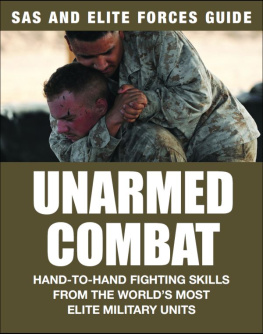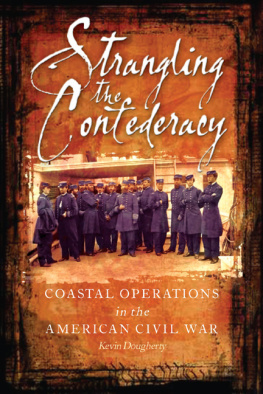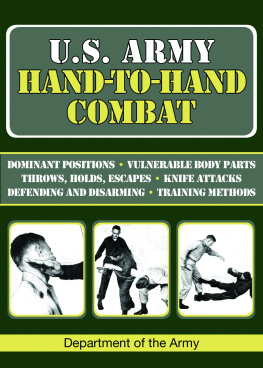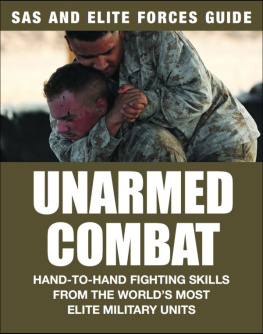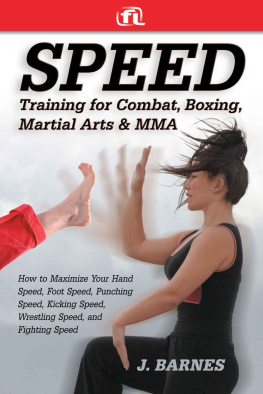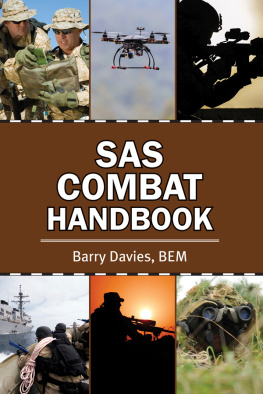UNARMED
COMBAT
SAS and Elite Forces Guide
MARTIN J. DOUGHERTY

This digital edition first published in 2011
Published by
Amber Books Ltd
Bradleys Close
7477 White Lion Street
London N1 9PF
United Kingdom
Website: www.amberbooks.co.uk
Appstore: itunes.com/apps/amberbooksltd
Facebook: www.facebook.com/amberbooks
Twitter: @amberbooks
Copyright 2011 Amber Books Ltd
ISBN: 978 190 869604 5
ILLUSTRATIONS
Tony Randell
All rights reserved. With the exception of quoting brief passages for the purpose of review no part of this publication may be reproduced without prior written permission from the publisher. The information in this book is true and complete to the best of our knowledge. All recommendations are made without any guarantee on the part of the author or publisher, who also disclaim any liability incurred in connection with the use of this data or specific details.

www.amberbooks.co.uk
Contents
PREPARATION
TOOLS OF THE TRADE
IN ACTION
Other titles in this series:
SAS and Elite Forces Guide: Crisis Survival
SAS and Elite Forces Guide: Military Survival
Survival Techniques

Website: www.amberbooks.co.uk
Appstore: itunes.com/apps/amberbooksltd
Facebook: www.facebook.com/amberbooks/
Twitter: @amberbooks

1
Know your enemy is a profound military maxim. It also applies to self-defence.
The Threat
A key element in military planning is to make an assessment of the threat likely to be faced. This permits the correct equipment to be issued and a suitable plan to be put in place. For example, a team assaulting an oil rig seized by gunmen would not expect to encounter armoured vehicles and can probably dispense with antitank weapons. Combat will likely be at close quarters where sub-machine guns and shotguns are more useful than sniper rifles. No special forces team would ever be committed without at least some understanding of the threat to be faced.
The same philosophy applies to self-defence. In order to defend yourself effectively you need to understand the nature of the threat as it really is, rather than relying on an impression gained from movies and headlines. What sort of threat are you likely to face? What will an aggressor actually try to do? What are the odds of being faced with a weapon or a gang?
FALSE IMPRESSIONS
It may seem from a cursory look at the news that the streets are a battleground, a deadly arena of fists, guns and knives. In fact armed attacks are not at all common, though they are serious enough to merit attention when they do happen. Lesser levels of violent assault are more frequent, but even these are not as likely as many people think.
Extreme threats
Generally it is better to surrender property than to tackle weapons, but if you think you are going to be harmed anyway, fighting is your only option.

Be aware!
Most robberies and many assaults are opportunistic. Distractions such as phones and music can make you vulnerable

The perception of constant street violence derives mainly from the fact that it gets reported while its absence does not. Headlines like nobody got stabbed today would not sell a lot of newspapers, so we are told about incidents that do happen and never hear about the millions of people who go about their business unharmed. To illustrate that, look at this page. The words stand out but there is a lot more white space between and around them. You do not notice it because it is not brought to your attention. So it is with violence a lot more people do not encounter violence than do. That said, if it happens to you then it does not matter how uncommon it is.
THE LIKELY THREAT
As a rule, civilians are most likely to face an unarmed threat. This does not mean the level of threat is trivial anyone is capable of killing with their bare hands if they try hard enough, and being kicked while helpless on the ground can result in death or permanent injury. Attacks with weapons are less common. When they do occur they tend to involve small, easily carried and concealed weapons, such as knives, or items that can be quickly picked up and used, such as glasses and bottles.
Blunt-instrument attacks are generally more premeditated, as the weapon has to be carried openly if it is large enough to be any use. Other weapons such as chains and samurai swords are quite rare. As to firearms, in Britain at least attacks are still relatively rare.
There are two likely forms an attack might take. The first is a sudden assault with no warning. This is almost always premeditated, and the aggressor might use deception or stealth to get close enough to attack. The other sort of assault gives you more warning, but there are other problems associated with it. This is an escalating confrontation that becomes violent.
Surprise Attack
Surprise attacks are very hard to deal with. Not just because you can be taken out by the first blow, but also because psychologically it is very hard to get into a combative mindset while you are shocked and hurt. Military training teaches troops to switch on their aggression instantly, and good self-defence training does too. In both cases the aggression is controlled and directed; there is no point in firing or flailing wildly.
However, it is better not to be caught by surprise if at all possible. Stealthy attackers can be somewhat countered by:
Staying in lit areas.
Not walking close by blind spots such as corners.
Not allowing yourself to be distracted by music or your phone.
Deceptive attackers often use distraction techniques such as asking you the time or for cigarettes. This allows them to get close enough to launch their attack without warning. If at all possible, you should not allow anyone you do not trust within arms reach.
Knife threat
Any armed threat is extremely serious. It may be better to surrender property than to tackle a weapon, but be aware that some attackers will hurt you even after being given what they want.
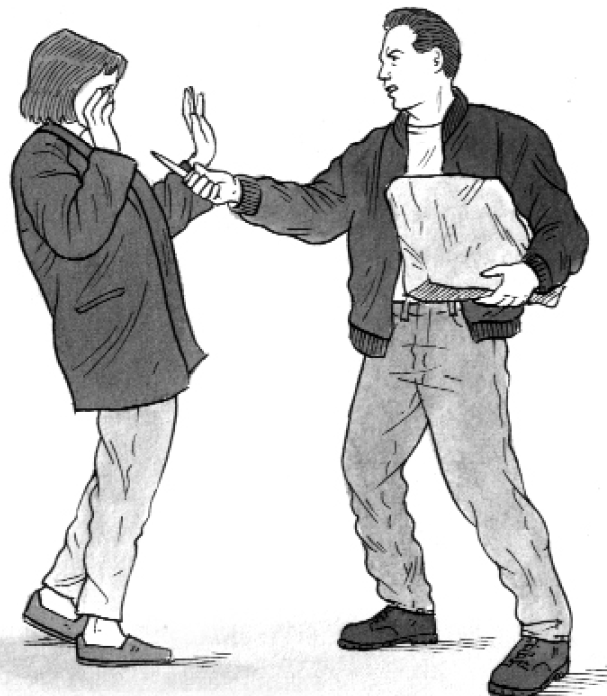
Confrontation
Confrontations erupt over all kinds of things, especially where alcohol is involved. Most do not lead to violence, and of those that do, many could have been prevented. The key is to remain calm and not allow yourself to be drawn into an escalating confrontation, and never to allow anyone to get close to you while they are in an aggressive, confrontational state.
The usual pattern for a confrontation is for it to begin with an exchange of words which become more abusive, aggressive and threatening. This is often accompanied by arm-waving and posturing, along with violence against objects. An individual who mouths off, inviting you to come here if you think youre hard enough while remaining out of reach or backing away generally does not want to fight. Unless you say something that pricks his ego enough that he just has to attack you, he will normally satisfy himself with a barrage of insults and go off to tell his mates he won. That is not very pleasant but it is a better outcome than a fight.

